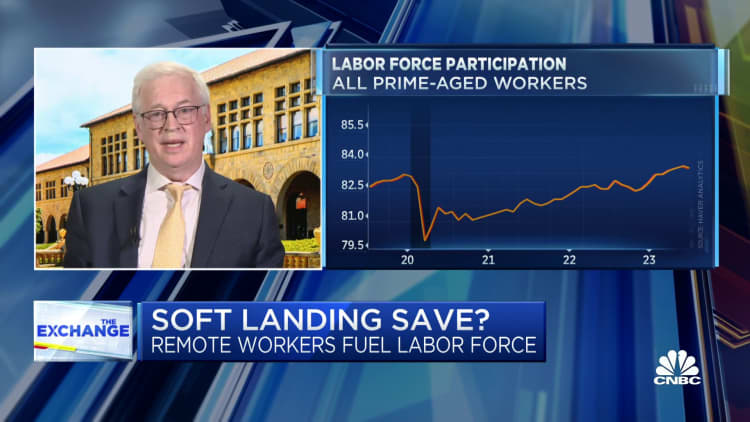Morsa Images | Digitalvision | Getty Images
The share of workers being called back to the office has flatlined, suggesting the pandemic-era phenomenon of widespread remote work has become a permanent fixture of the U.S. labor market, economists said.
“Return to the office is dead,” Nick Bloom, an economics professor at Stanford University and expert on the work-from-home revolution, wrote this week.
In May 2020 — the early days of the Covid-19 pandemic — 61.5% of paid, full workdays were from home, according to the Survey of Working Arrangements and Attitudes. That share fell by about half through 2022 as companies called employees back to in-person work.
However, the story has changed in 2023.
The share of paid work-from-home days has been “totally flat” this year, hovering around 28%, said Bloom in an interview with CNBC. That’s still four times greater than the 7% pre-pandemic level. The U.S. Census Bureau’s Household Pulse Survey shows a similar trend, he said.
Meanwhile, Kastle data that measures the frequency of employee office swipe-ins shows that office occupancy in the 10 largest U.S. metro areas has flatlined at around 50% in 2023, Bloom said.
“We are three and a half years in, and we’re totally stuck,” Bloom said of remote work. “It would take something as extreme as the pandemic to unstick it.”
Why remote work has had staying power
The initial surge of remote work was spurred by Covid-19 lockdowns and stay-at-home orders.
But many workers came to like the arrangement. Among the primary benefits: no commute, flexible work schedules and less time getting ready for work, according to WFH Research.
The trend has been reinforced by a hot job market in the U.S. since early 2021, giving workers unprecedented leverage. If a worker didn’t like their company benefits, odds were good they could quit and get a job with better work arrangements and pay elsewhere.
Research has shown that the typical worker equates the value of working from home to an 8% pay raise.
More from Personal Finance:
U.S. passport delays have eased
Don’t make these common 401(k) mistakes
How a tax break can help heat your home more efficiently
However, the work-from-home trend isn’t just a perk for workers. It has been a profitable arrangement for many companies, economists said.
Among the potential benefits: reduced costs for real estate, wages and recruitment, better worker retention and an expanded pool from which to recruit talent. Meanwhile, worker productivity hasn’t suffered, Bloom said.
“What makes companies money tends to stick,” he said.
Remote policies show ‘incredible diversity’
These days, most remote work is done as part of a “hybrid” arrangement, with some days at home and the rest in the office. About 47% of employees who can work from home were hybrid as of October 2023, while 19% are full-time remote and 34% are fully on site, according to WFH Research.
About 11% of online job postings today advertise positions as fully remote or hybrid, versus 3% before the pandemic, said Julia Pollak, chief economist at ZipRecruiter.
While remote work is the labor market’s new normal, there’s significant variety from company to company, Pollak said.

For example, 7% of workers are required to be in the office one day a week, while 9% are required in two days, 13% three days and 8% four days, according to a recent ZipRecruiter employer survey. Nearly 1 in 5, 18%, have discretion over their in-person workdays.
“The new normal is this incredible diversity,” Pollak said.
“There’s still a lot of experimentation going on,” she said. “But the aggregate effect is that remote work is steady.”
Why remote work will likely increase beyond 2025
While it’s unlikely that the prevalence of remote work will ever decline to its pre-pandemic level, it’s possible that a U.S. recession — and a weaker job market — may cause it to slide a bit, economists said.
“Employers say the biggest benefit of remote work is retention,” Pollak said. In a labor market with more slack, “retention gets much easier.”
However, since work-from-home arrangements also save companies money, it’s likely a severe recession would be necessary to see a meaningful decline, Bloom said.
Long-term trends suggest the share of employees who work from home is only likely to grow from here, possibly starting in 2025, Bloom said.
For example, improving technology will make remote work easier to facilitate, Bloom said. Younger firms and CEOs also tend to be more enthusiastic about hybrid work arrangements, meaning they’ll get more popular over time as existing business heads retire, he added.
Don’t miss these stories from CNBC PRO:
 EU News Digest Latest News & Updates
EU News Digest Latest News & Updates



